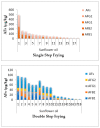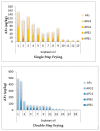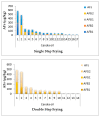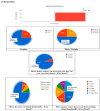Risk Assessment of Hepatocellular Carcinoma with Aflatoxin B1 Exposure in Edible Oils
- PMID: 36006209
- PMCID: PMC9415889
- DOI: 10.3390/toxins14080547
Risk Assessment of Hepatocellular Carcinoma with Aflatoxin B1 Exposure in Edible Oils
Abstract
Contamination of edible oils with aflatoxins (AFs) is a universal issue due to the detrimental effects of aflatoxins on human health and the fact that edible oils are a major source of fungal growth, particularly storage fungi (Aspergillus sp.). The objective of this study was to assess aflatoxin B1 (AFB1) in edible oil used in fried food in order to determine the risk of cancer from AFB1 exposure through cooked food using the FAO/WHO's and EFSA's margin of exposure (MOE) quantitative liver cancer risk approaches. Using Mycosep 226 columns and HPLC-FLD, 100 samples of cooking oils (soybean, canola, and sunflower oil) from different food points were analyzed for contamination with aflatoxins. Of all the samples tested, 89% were positive for total aflatoxins and AFB1, with 65% indicating AF concentrations beyond permitted levels. Canola oil was found to contain higher levels of AFB1 and AFs than soybean and sunflower oil. Almost 71 percent of canola oil samples (range of 54.4-281.1 µg/kg) were contaminated with AF levels higher than the proposed limits of the European Union (20 µg/kg). The consumption of canola oil samples used in fried foods had MOE values that were significantly lower as compared to sunflower and soybean oils, indicating that risk reduction is feasible. Additionally, compared to soybean and sunflower oil, canola oil exhibited a greater threat of liver cancer cases linked to AFB1 exposure (17.13 per 100,000 males over 35 and 10.93 per 100,000 females over 35). Using a quantitative liver cancer approach, health risk valuation demonstrated that males and females over the age of 35 are at significant risk of developing liver cancer. The health risk assessment exposed that the males and female over the age of 35 are at considerable risk of liver cancer by using a quantitative liver cancer approach. The innovation of this study lies in the fact that no such study is reported related to liver cancer risk evaluation accompanied with AFB1 exposure from consumed edible oil. As a result, a national strategy must be developed to solve this problem so that edible oil products are subjected to severe regulatory examination.
Keywords: AFB1; AFs; Faisalabad; HPLC; MOE; dietary intake; quantitative liver cancer; risk assessment.
Conflict of interest statement
The authors declare no conflict of interest.
Figures






Similar articles
-
Prevalence and probabilistic health risk assessment of aflatoxins B1, B2, G1, and G2 in Iranian edible oils.Environ Sci Pollut Res Int. 2018 Dec;25(35):35562-35570. doi: 10.1007/s11356-018-3510-0. Epub 2018 Oct 23. Environ Sci Pollut Res Int. 2018. PMID: 30353428
-
Occurrence of Aflatoxins in Edible Vegetable Seeds and Oil Samples Available in Pakistani Retail Markets and Estimation of Dietary Intake in Consumers.Int J Environ Res Public Health. 2021 Jul 29;18(15):8015. doi: 10.3390/ijerph18158015. Int J Environ Res Public Health. 2021. PMID: 34360308 Free PMC article.
-
Exposure assessment of aflatoxins and zearalenone in edible vegetable oils in Shandong, China: health risks posed by mycotoxin immunotoxicity and reproductive toxicity in children.Environ Sci Pollut Res Int. 2023 Jan;30(2):3743-3758. doi: 10.1007/s11356-022-22385-2. Epub 2022 Aug 11. Environ Sci Pollut Res Int. 2023. PMID: 35953745
-
Recent Progress on Techniques in the Detection of Aflatoxin B1 in Edible Oil: A Mini Review.Molecules. 2022 Sep 20;27(19):6141. doi: 10.3390/molecules27196141. Molecules. 2022. PMID: 36234684 Free PMC article. Review.
-
Comprehensive Review of Aflatoxin Contamination, Impact on Health and Food Security, and Management Strategies in Pakistan.Toxins (Basel). 2022 Dec 2;14(12):845. doi: 10.3390/toxins14120845. Toxins (Basel). 2022. PMID: 36548742 Free PMC article. Review.
Cited by
-
Analytical Validation of a Direct Competitive ELISA for Multiple Mycotoxin Detection in Human Serum.Toxins (Basel). 2022 Oct 25;14(11):727. doi: 10.3390/toxins14110727. Toxins (Basel). 2022. PMID: 36355977 Free PMC article.
-
A field-portable electrochemical immunosensor based on a multifunctional Ag2O/g-C3N4@MA-DBB covalent organic framework receptor interface for single-step detection of aflatoxin M1 in raw milk samples.Nanoscale Adv. 2024 Jul 31;6(18):4693-4703. doi: 10.1039/d4na00327f. eCollection 2024 Sep 10. Nanoscale Adv. 2024. PMID: 39263407 Free PMC article.
-
Simultaneous detection of multiple mycotoxins in Radix Dipsaci and estimation of exposure risk for consumers.Sci Rep. 2024 Oct 1;14(1):22762. doi: 10.1038/s41598-024-73597-0. Sci Rep. 2024. PMID: 39354043 Free PMC article.
-
Liver Cancer Etiology: Old Issues and New Perspectives.Curr Oncol Rep. 2024 Nov;26(11):1452-1468. doi: 10.1007/s11912-024-01605-7. Epub 2024 Oct 10. Curr Oncol Rep. 2024. PMID: 39388026 Review.
References
-
- Moein B., Javanmardi F., Sadeghi E., Shokri S., Hossieni H., Oliveira C.A., Khaneghah A.M. The prevalence of aflatoxins in commercial baby food products: A global systematic review, meta-analysis, and risk assessment study. Trends Food Sci. Technol. 2021;114:100–115.
-
- Jeremy R.S., Brown D.L. Aflatoxin contamination in Haitian peanut products and maize and the safety of oil processed from contaminated peanuts. Food Control. 2015;56:114–118.
-
- Carolina F.C., Cirelli A.C., Gonçalves B.L., Barnabé E.M., Petta T., Franco L.T., Javanmardi F., Khaneghah A.M., Lee S.H., Corassin C.H. Mycotoxin occurrence in breast milk and exposure estimation of lactating mothers using urinary biomarkers in São Paulo, Brazil. Environ. Pollut. 2021;279:116938. - PubMed
-
- Xi Y., Li Z., Zhao M., Lau S.C.S., Tan H.R., Teh W.J., Yang H., Zheng C., Zhang Y. Quantification of aflatoxin B1 in vegetable oils using low temperature clean-up followed by immuno-magnetic solid phase extraction. Food Chem. 2019;275:390–396. - PubMed
Publication types
MeSH terms
Substances
LinkOut - more resources
Full Text Sources
Medical
Research Materials

